|
|
||||

LOWLAND CONIFER MANAGEMENT WORKSHOP
TERRACE BAY INN,
ESCANABA, MICHIGAN
19-20 FEBRUARY, 1998
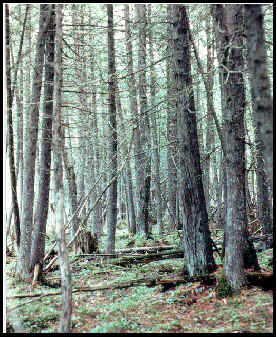 This workshop was held in association
with the Michigan
Society of American Foresters state meeting and co-sponsored
by the Michigan Chapter of the Wildlife
Society. Lowland conifers make up the fourth
most abundant forest type in Michigan, after northern hardwoods, aspen, and
oak. They lie in critical parts of watersheds, provide vital wildlife habitat,
and support a significant forest products industry. The
goals of this event were to 1) provide a review of
the ecology, distribution, structure, health, and history of this forest type,
2) examine its value from a range of perspectives, and 3) review management
alternatives and challenges in light of various ownership objectives, operational
constraints, cost constraints, current regulations, and our limited understanding.
This workshop was held in association
with the Michigan
Society of American Foresters state meeting and co-sponsored
by the Michigan Chapter of the Wildlife
Society. Lowland conifers make up the fourth
most abundant forest type in Michigan, after northern hardwoods, aspen, and
oak. They lie in critical parts of watersheds, provide vital wildlife habitat,
and support a significant forest products industry. The
goals of this event were to 1) provide a review of
the ecology, distribution, structure, health, and history of this forest type,
2) examine its value from a range of perspectives, and 3) review management
alternatives and challenges in light of various ownership objectives, operational
constraints, cost constraints, current regulations, and our limited understanding.
The largest portion of the workshop entailed field visits to four lowland conifer sites. These site visits are the focus of this web page. The first two sites demonstrated some of the ecological and landscape issues. The second two sites dealt with harvesting and management issues. Throughout the entire workshop, the inter-relatedness of natural resource values was emphasized.
About 150 people attended. Each person received a technical binder with an annotated bibliography of selected literature relevant to lowland conifer management and ecology. A limited number of copies are available for $15. Contact Mark Bale at 906-663-4687.
Field trips were prefaced with three indoor sessions presented for background information that would be more difficult to demonstrate in the field. Jem Castillo, from Michigan State University, delivered the messages related to the present distribution of the lowland conifer type and its economic values. Kurt Pregitzer, from Michigan Technological University, discussed lowland conifer ecology and development. Jim Hammill, from the Michigan DNR, challenged the group with issues relating to wildlife habitat values.
![]() SITE ONE: Malman
Marsh on the Hiawatha National Forest. This site included five stops demonstrating
brush control strategies, ecological classification, lessons from past strip
cutting, current findings from a long-term research project, and a small deer
exclosure.
SITE ONE: Malman
Marsh on the Hiawatha National Forest. This site included five stops demonstrating
brush control strategies, ecological classification, lessons from past strip
cutting, current findings from a long-term research project, and a small deer
exclosure.
![]() SITE TWO: An mature cedar stand
and a major deer exclosure project.
SITE TWO: An mature cedar stand
and a major deer exclosure project.
![]() SITE THREE: Long-term cedar
harvest impacts in the Perkins deeryard on the Escanaba River State Forest.
SITE THREE: Long-term cedar
harvest impacts in the Perkins deeryard on the Escanaba River State Forest.
![]() SITE FOUR: A private timber
sale on Doug Bovin's property.
SITE FOUR: A private timber
sale on Doug Bovin's property.
To return to this index, click
on the little tree. ![]()
| MSAF Home |
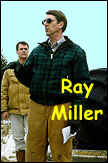 SITE
ONE - STOP ONE: Ray Miller
(MSU UP Tree Improvement Center) presented some of the management history at
Malman Marsh. Strip cuts were done in 1965. Harvested strips treated with an
American Ranger (giant rototiller) in 1988 resulted in poor tree regeneration
where the microtopography was eliminated. Small mounds which are needed for
tree establishment were removed. Terry Alexander of T&S Contracting,
Inc. displayed several pieces of heavy duty brush cutting equipment. He has
had success in retarding regrowth of alder by cutting it at ground level with
a blunt cutting edge rather than a sharpened one. This effectively "shocks"
the lower stem and root collar thus diminishing resprouting capability. The
frayed stems then dry out, further retarding regrowth. Ray can be reached at
906-786-1575 or rmiller@msu.edu. Terry can be reached
at 906-474-6313 or t&scontracting@uplogon.com.
SITE
ONE - STOP ONE: Ray Miller
(MSU UP Tree Improvement Center) presented some of the management history at
Malman Marsh. Strip cuts were done in 1965. Harvested strips treated with an
American Ranger (giant rototiller) in 1988 resulted in poor tree regeneration
where the microtopography was eliminated. Small mounds which are needed for
tree establishment were removed. Terry Alexander of T&S Contracting,
Inc. displayed several pieces of heavy duty brush cutting equipment. He has
had success in retarding regrowth of alder by cutting it at ground level with
a blunt cutting edge rather than a sharpened one. This effectively "shocks"
the lower stem and root collar thus diminishing resprouting capability. The
frayed stems then dry out, further retarding regrowth. Ray can be reached at
906-786-1575 or rmiller@msu.edu. Terry can be reached
at 906-474-6313 or t&scontracting@uplogon.com.
SITE ONE - STOP TWO: Greg Kudray (Michigan Technological University) spoke about the ecological classification system developed for wetlands in the Hiawatha National Forest. The classification is first split into mineral soil and organic soil wetlands. The next division is based on 1) hydrogeomorphology - landform controlled groundwater influence reflected by pH and vegetation (creating an acidic, species poor group and a base enriched, species rich group) and 2) drainage/aeration - a forested or non-forested division. Twelve different forested types are further differentiated based on landform, soil and vegetation indicators. To view the one-page key, click here. Greg can be reached at 906-523-4817 or gmkudray@mtu.edu.
SITE ONE - STOP THREE: Mike Lanasa (Hiawatha National Forest) described the results of strip cutting cedar, the method recommended by research. Harvested strips, while fully stocked with balsam fir, spruce, and paper birch, lack cedar which makes up 90% of the uncut residual strips. This is a fairly common result in areas where deer overwinter. Possible alternatives to increase cedar would be to either wait until the shorter lived competitors in the stand die out or to cut them prior to the regeneration cut. In addition, with high deer populations a shelterwood to establish cedar regeneration followed by a prompt removal cut to open the area up would reduce the pressure from yarding deer. Mike can be reached at 906-786-4062 or mlanasa@fs.fed.us.
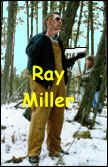 SITE
ONE - STOP FOUR: Ray Miller shared some of the research
ideas about cedar regeneration and stand development. Because smaller diameter
stems appear to respond very well to release, even at older ages, diameter-limit
cutting may be an acceptable method for cedar harvest. The Cedar Action Group
has been involved with the establishment of 33 monitoring plots in lowland conifers
across the U.P. Over time, more may be understood about the requirements of
cedar regeneration and seedling establishment. Ray can be reached at 906-786-1575
or rmiller@msu.edu.
SITE
ONE - STOP FOUR: Ray Miller shared some of the research
ideas about cedar regeneration and stand development. Because smaller diameter
stems appear to respond very well to release, even at older ages, diameter-limit
cutting may be an acceptable method for cedar harvest. The Cedar Action Group
has been involved with the establishment of 33 monitoring plots in lowland conifers
across the U.P. Over time, more may be understood about the requirements of
cedar regeneration and seedling establishment. Ray can be reached at 906-786-1575
or rmiller@msu.edu.
SITE ONE - STOP FIVE: The last stop demonstrated the effects of removing too much micro-relief on lowland conifer sites. Direct seeding and natural regeneration plots show no success. Only planting within an effective deer exclosure has proven successful. Trees planted outside the exclosure have not survived. Liming to raise soil pH did not prove to be an effective treatment to increase cedar regeneration. For more information contact Mike Lanasa at 906-786-4062 or mlanasa@fs.fed.us.
SITE TWO - STOP ONE: Still
on the Hiawatha National Forest, we traveled along county roads to a site with
older and larger cedar. The last harvest was at settlement times, except for
some old strips. Kevin Doran (Hiawatha National Forest)
spoke about habitat qualities and the kinds of wildlife that utilize lowland
conifer associations. Many migrating songbirds will use these types. The role
of snags, large downed and woody debris, and other features of older forests
were discussed. Brad Stermer
(Michigan DEQ) spoke about some of the hydrological aspects and values of lowland
conifers. Kevin can be reached at 906-786-2512 and Brad at 906-786-2351.
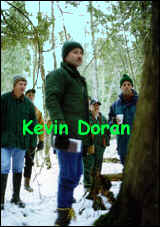
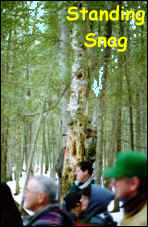
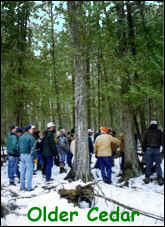
![]() Index
Index
SITE TWO - STOP TWO: Within walking distance through the cedar stand, we came along an electric fencing project enclosing about 26 acres. Chuck Cutter (Hiawatha National Forest) explained the intent was to study the effects of various silvicultural practices on forest regeneration, cedar in particular. Although well-built, the fence did not serve the intended purpose. Deer passed through and over the fence on a regular basis. Electrical shorts were common from fallen trees and for other reasons. Brad Bender (MSU UP Tree Improvement Center) led a discussion on various fence designs applicable to Lake States situations. A summary of these designs can be found in the annotated bibliography. Chuck can be reached at 906-474-6442 and Brad at 906-786-1575.
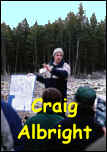
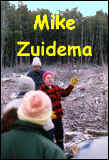 SITE THREE: The Perkins deeryard is
located on the Escanaba River State Forest. This yard sustains an ongoing experimental
harvest looking at cedar regeneration and the impact on the deer herds. Years
ago, strip cuts were placed within the deer yard. The current management plan
calls for some additional strip removals and a checkerboard cutting pattern
with 1.6 acre blocks. The yard is heavily used by deer, indicated by heavy browse,
rapid defoliation of cut cedar, numerous trails "paved" with scat,
and the observation of high numbers during the winter. Craig
Albright (Michigan DNR) presented the objectives for the area and discussed
the value of this particular yard in the landscape. Dean
Wilson (Michigan DNR) and Mike Zuidema (retired Michigan DNR)
explained some of the strategy behind the current experimental harvest. Craig
can be reached at 906-786-2351 or albrightc@michigan.gov,
Dean at 906-786-2354 or wilsonde@michigan.gov,
and Mike at 906-786-3137.
SITE THREE: The Perkins deeryard is
located on the Escanaba River State Forest. This yard sustains an ongoing experimental
harvest looking at cedar regeneration and the impact on the deer herds. Years
ago, strip cuts were placed within the deer yard. The current management plan
calls for some additional strip removals and a checkerboard cutting pattern
with 1.6 acre blocks. The yard is heavily used by deer, indicated by heavy browse,
rapid defoliation of cut cedar, numerous trails "paved" with scat,
and the observation of high numbers during the winter. Craig
Albright (Michigan DNR) presented the objectives for the area and discussed
the value of this particular yard in the landscape. Dean
Wilson (Michigan DNR) and Mike Zuidema (retired Michigan DNR)
explained some of the strategy behind the current experimental harvest. Craig
can be reached at 906-786-2351 or albrightc@michigan.gov,
Dean at 906-786-2354 or wilsonde@michigan.gov,
and Mike at 906-786-3137.
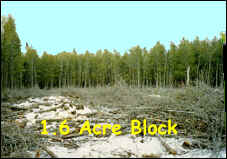
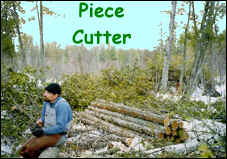
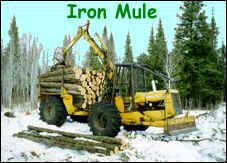
SITE FOUR - STOP ONE: Doug Bovin (private forest owner) agreed to host the group on his property north of Rapid River. Doug has been working with Mead Corporation to develop a harvest plan that meets his objectives as a landowner. Vic Lyberg (MeadWestvaco) explained the operational plan and constraints of the landscape. This stop is largely a mix of tamarack and black spruce, with the area succeeding to black spruce. There is a mix of balm, aspen, and other tree species. This area is scheduled to be clearcut. Regeneration pockets and areas of mostly smaller material will be avoided to ensure reasonable seed sources. These pockets will also serve, in part, as refugia for wildlife species in the area. Vic Lyberg can be reached at 906-786-1660 x2182.
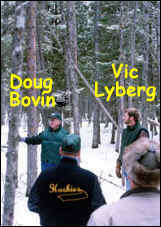
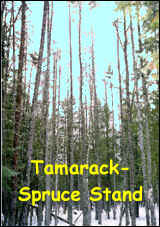
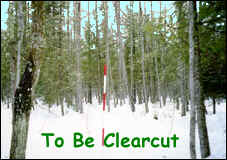
SITE FOUR - STOP TWO: Across Doug Bovin's timber sale, there are several runs of good cedar bolts. These runs will be clearcut, bringing high dollar values at the current market rates. Many of the shorter-lived tree species have died, such as balm, aspen, and balsam fir. This particular run of cedar sharply transitions into a mixed tamarack-spruce stand of lower stand density. Terry Minzey (DNR-Wildlife) pointed out that proper cedar management varies from place to place. Cedar regeneration is generally obtainable in the northern Upper Peninsula due to lower winter deer densities. In the southern UP, it is often more difficult, if not impossible, to achieve cedar regeneration. By leaving as much cedar as possible, future options will be maximized as information grows and if ecological pressures decrease. Most UP cedar are 100 years old, far from the natural longevity. Therefore, leaving cedar "on the stump" is a biological option, unlike some other species. Terry can be reached at 906-452-6227 or minzeyt@michigan.gov.
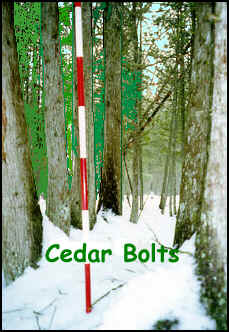
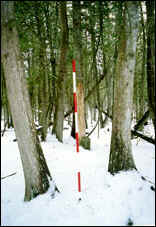
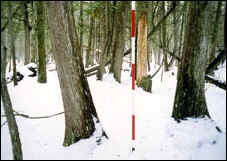
SITE FOUR - STOP THREE: Much of Doug's lowland conifer acreage can be characterized by mixed species, medium stand densities, and variable quality. In these areas, Charlie Becker (MeadWestvaco) explained the proposal to remove bolt material, leaving smaller stems to grow and to serve as seed sources. Residual damage is to be kept to a minimum and loggers will avoid pockets of advanced regeneration. This strategy will provide residual forest canopy, provide for future stand quality, maintain cedar in the landscape, and meet Doug's objectives to maximize revenue and retain as much hunting habitat as possible. Although landowner objectives are the driving force behind private land management, consultants and resource managers explain the trade-offs inherent with particular management options. Charlie can be reached at 906-786-1660 x2180 or cab7@meadwestvaco.com.
SITE FOUR - STOP FOUR: The merchantable aspen will be removed from these transition areas between upland and lowland types. The objective is to maintain the advanced fir regeneration where possible and allow openings to regenerate with aspen. Doug prefers the fir, where possible, for the visual quality along access roads. Timber removal and utilization in transition areas is somewhat controversial in some settings, and poses questions with answers that sometimes remain elusive.

This website is maintained by Bill Cook, Michigan State University Extension
Forest in the Upper Peninsula. Comments, questions,
and suggestions are gratefully accepted.
Last update of this page
was
30 September, 2005
This site is hosted by School of Forest Resources and Environmental Science at Michigan Technological University.